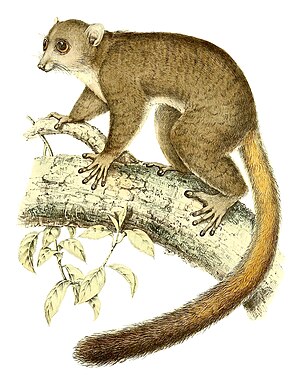Southern giant mouse lemur
| Southern giant mouse lemur | ||||||||||||
|---|---|---|---|---|---|---|---|---|---|---|---|---|

Southern giant mouse lemur ( Mirza coquereli ) |
||||||||||||
| Systematics | ||||||||||||
|
||||||||||||
| Scientific name | ||||||||||||
| Mirza coquereli | ||||||||||||
| ( Grandidier , 1867) |
The southern or large giant mouse lemur ( Mirza coquereli ) is a primate species from the lemur group .
features
Southern giant lemurs reach a head body length of 23 to 27 centimeters, plus a tail that is around 32 centimeters long. Their weight is 285 to 335 grams, making them the larger of the two species of giant mouse lemur . Their fur is gray-brown on the upper side, the underside is light gray. The face is rounded, the eyes are relatively large, as are the hairless ears. The long tail is bushy and darkens towards the tip.
distribution and habitat
Like all lemurs, southern giant lemurs are native to Madagascar , and their range includes the dry deciduous and coastal forests in the west of the island. They occur up to 700 meters above sea level and are often found near rivers.
Lifestyle and diet
These primates are nocturnal. During the day they sleep in self-made nests made of twigs and leaves, these nests have a diameter of around 50 centimeters and are often in the canopy. At night they go in search of food, mainly moving on all fours through the branches and mostly staying at heights of 5 to 10 meters. Occasionally they also come to the ground while searching for food.
In contrast to the northern giant mouse lemur, they are solitary, they sleep alone in nests and also go for food individually. The females establish grazing areas of 1 to 4 hectares, which overlap with those of conspecifics. Males have a similarly large territory outside of the mating season, but expand it up to three times during the breeding season. The boundaries of their home areas are marked with urine and the secretion of their anal glands. A number of sounds are known for the animals, but at this point in time no precise function can be assigned.
In contrast to other lemurs , they do not hibernate or go into daily paralysis , but their level of activity is limited in the dry season. Southern giant lemurs are omnivores that eat fruits, flowers, buds, tree sap, insects and other small animals. The composition of the food varies depending on the season; fruits are more common, especially in the rainy season. In the dry season, insect excretions can make up up to 60% of the diet. What is unusual for lemurs is that they sometimes also eat small vertebrates such as fledglings, frogs , lizards and even lemurs .
Reproduction
As with most lemurs, reproduction is seasonal and occurs at the beginning of the rainy season (around November). The females are often only ready to conceive for a few days or even only one night. At this time, the males establish significantly larger roaming areas and also have noticeably enlarged testicles, which suggests that they are fighting among themselves for mating privileges. After a gestation period of around 90 days, the female gives birth to one or two young animals - twins are more common than single births. These are not very developed and spend their first few weeks in their mother's nest. They leave it after three to four weeks, and after around four and a half months they are weaned. Females are sexually mature at around 10 months.
Danger
Southern giant lemurs are very common in some areas, but their habitats are becoming increasingly smaller and fragmented as a result of slash and burn. In some places they are probably also hunted for their meat. The IUCN estimates that the total population has declined by 20 to 25% in the last 15 years (three generations) and lists the species as " near threatened ".
The species is no longer kept in Europe, former owners are London and Berlin.
literature
- Nick Garbutt: Mammals of Madagascar. A Complete Guide. Yale University Press, New Haven CT 2007, ISBN 978-0-300-12550-4 .
- Thomas Geissmann : Comparative Primatology. Springer-Verlag, Berlin et al. 2002, ISBN 3-540-43645-6 .
supporting documents
Web links
- Information and photos at arkive.org
- Mirza coquereli onthe IUCN Red List of Threatened Species . Retrieved April 18, 2009.